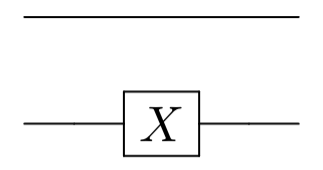Math:
If you are familiar with tensor products, observe that $I \otimes X$ gives the desired matrix. Showing the steps of this computation,
$I \otimes X = \begin{pmatrix}1 &0\\0 & 1 \end{pmatrix} \otimes \begin{pmatrix}0 &1\\1 & 0 \end{pmatrix} = \begin{pmatrix}1\begin{pmatrix}0 &1\\1 & 0 \end{pmatrix} & 0 \begin{pmatrix}0 &1\\1 & 0 \end{pmatrix} \\0\begin{pmatrix}0 &1\\1 & 0 \end{pmatrix} & 1\begin{pmatrix}0 &1\\1 & 0 \end{pmatrix} \end{pmatrix} = \begin{pmatrix}0 & 1 & 0 & 0\\1 & 0 & 0 & 0\\ 0 & 0 & 0 & 1\\0 & 0 & 1 & 0 \end{pmatrix}$
To obtain the corresponding circuit, note that this tensor represents two gates applied at the same circuit depth on two qubits. That is, you would have an identity gate applied to the top qubit (equivalently, not applying any gate), and you would have the $X$ gate applied on the bottom qubit.
Shown as a circuit diagram:

Qiskit:
Using the following import, you can decompose a two qubit gate to a sequence of single qubit gates, as long as the input gate does not create entanglement.
from qiskit.quantum_info.synthesis import TwoQubitBasisDecomposer
You can find the code for this file here: https://github.com/Qiskit/qiskit-terra/blob/master/qiskit/quantum_info/synthesis/two_qubit_decompose.py (qiskit-terra/qiskit/quantum_info/synthesis/two_qubit_decompose.py).
However, as input to the gate decomposer, you need to create a 2-qubit gate corresponding to the matrix given. I am not sure how to do so, and will update my answer when I find out.
Further note that at the current time, n-qubit gate decomposition is not supported; you can only decompose 2-qubit gates.

